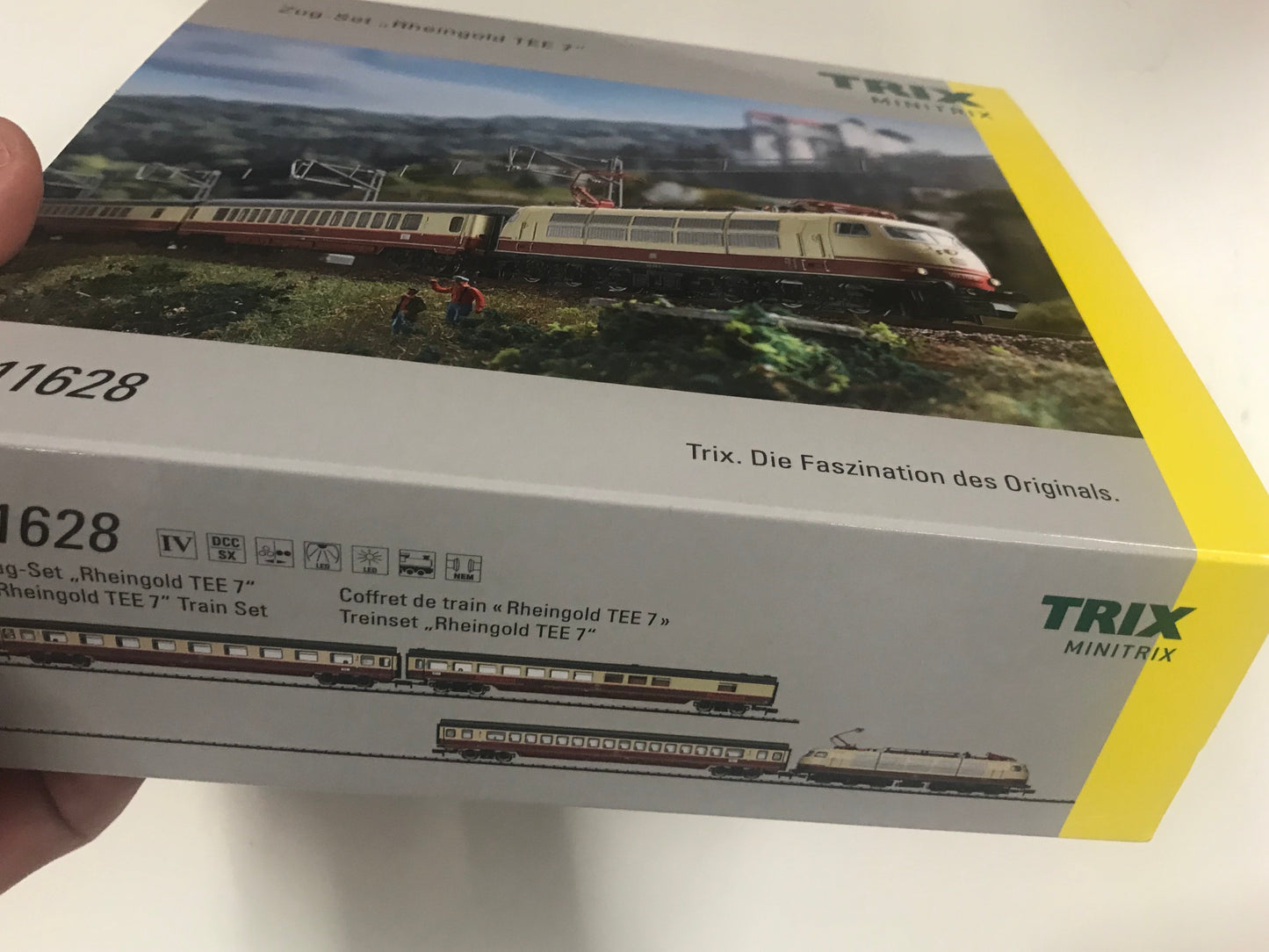Trix 11628 - Rheingold TEE 7 Train Set
Prototype: German Federal Railroad (DB) express locomotive, road number 103 178-0. C-C wheel arrangement. Built starting in 1970. 3 express train passenger cars consisting of the types Apmz 122, WRmh 132.1, and Avmz 111.1 The cars are painted and lettered completely in the design of the Rheingold train of 1984. Use: High quality long distance service, here in the Rheingold TEE 7 of 1984.
Model: The locomotive has a built-in digital decoder for operation with DCC, Selectrix, and Selectrix 2. The locomotive has a motor with a flywheel. 4 axles powered. Traction tires. The headlights and marker lights change over with the direction of travel. Warm white LEDs are used for the lighting. The cab lighting and engine room lighting can be controlled digitally.
No transformer or track included.
The locomotive has a close coupler mechanism. All of the functions can also be controlled in the digital format SX2.
Length over the buffers 122 mm / 4-13/16". The express train passenger cars have close coupler mechanisms.
Total length over the buffers 617 mm / 24-5/16". The set has special book packaging for a stylish presentation.
| DCC | SX2 | SX | |
|---|---|---|---|
| Headlight(s) | · | · | · |
| Engineer’s cab lighting | · | · | · |
| Light Function | · | · | |
| Long distance headlights | · | · | |
| Direct control | · | · | |
| Rear Headlights off | · | · | |
| Front Headlights off | · | · |
Highlights: Special book packaging for collectors. Reworked trucks. Reworked battery boxes.
One-time series. Delivery at the start of 2017.
The "Rheingold" had a rich tradition and ran starting in May 1965 as a Trans-Europe-Express (TEE) in the two-color TEE scheme of a crimson red belt line and an ivory window band. From May 23, 1982 on, its route was limited to Amsterdam – Basle SBB. A year later there were only two TEE trains left: the "Mediolanum" (Munich – Milan) made up of FS cars and the TEE 7/6 "Rheingold" that was viewed more as a tourist attraction. Starting with the summer schedule of 1983 all of the Rheingold cars were run with overhauled interiors and were provided with an orange decorative stripe below the windows for purposes of identification. New among the cars was the club car (type WGm 804) that presented the lettering "Rheingold-Club" on the sides. Three of these "new" club cars were made from former open seating cars and they now had a small galley and fifteen rather ordinary tables with 34 swiveling armchairs. In addition, three regular dining cars were available for the route Amsterdam – Basle. There were also fifteen compartment cars and six open seating cars. In the club cars the DB provided beer on tap and snacks among other things from the small bistro for the comfort of the passengers. Hired musical and folklore groups provided entertainment part of the time. In the summer of 1986, there was even a whirlpool tub in addition to an artificial palm for a couple of days to offer the opportunity for a soak. Indeed the "Rheingold" was now limited primarily to the route Amsterdam – Basle, yet it still occasionally ran through cars to Chiasso, Brig, and in the winter to Chur.
In addition, a branch train (TEE 17/16) to Munich with train separation/joining in Mannheim (later Mainz) rounded out the new concept. In the last two years of its existence (1986/87 as TEE 15/14), the through cars to/from Brig and Chiasso also disappeared. There were still through cars between Amsterdam and Chur only in the winter season. Up until May 30, 1987, the legendary "Rheingold" still snaked day after day through the maze of track in the Ruhr area, past the Cologne cathedral and the Lorelei cliffs, and crossed the Upper Rhine plains between the Black Forest and the Vosges. Yet with the start of the summer schedule on May 31, 1987 and the introduction of the EuroCity trains, the last TEE still running in Germany disappeared completely from the rails of the German Federal Railroad. Motive power for the "Rheingold" until its end was the class 103.1 electric locomotives as the classic flagship locomotive for TEE and IC trains. Regular production of them started in 1969, and by 1974, there were 145 of these powerful six-axle units with road numbers 103 101-245 on the DB roster. They were designed from the start for a speed of up to 265 km/h / 166 mph, but they were only allowed to run at a maximum speed of 200 km/h / 125 mph. The 103 units with their elegant streamlined shape and the Siemens rubber ring spring cardan shaft propulsion was the most powerful German electric locomotive and had an hourly rating of 7,780 kilowatts / 10,581 horsepower.
66616 LED lighting kit.
An add-on car to go with this set is available under item number Trix 15679.
Features:
Released in: - Fall New Items 2016
EAN/UPC: 4028106116285













